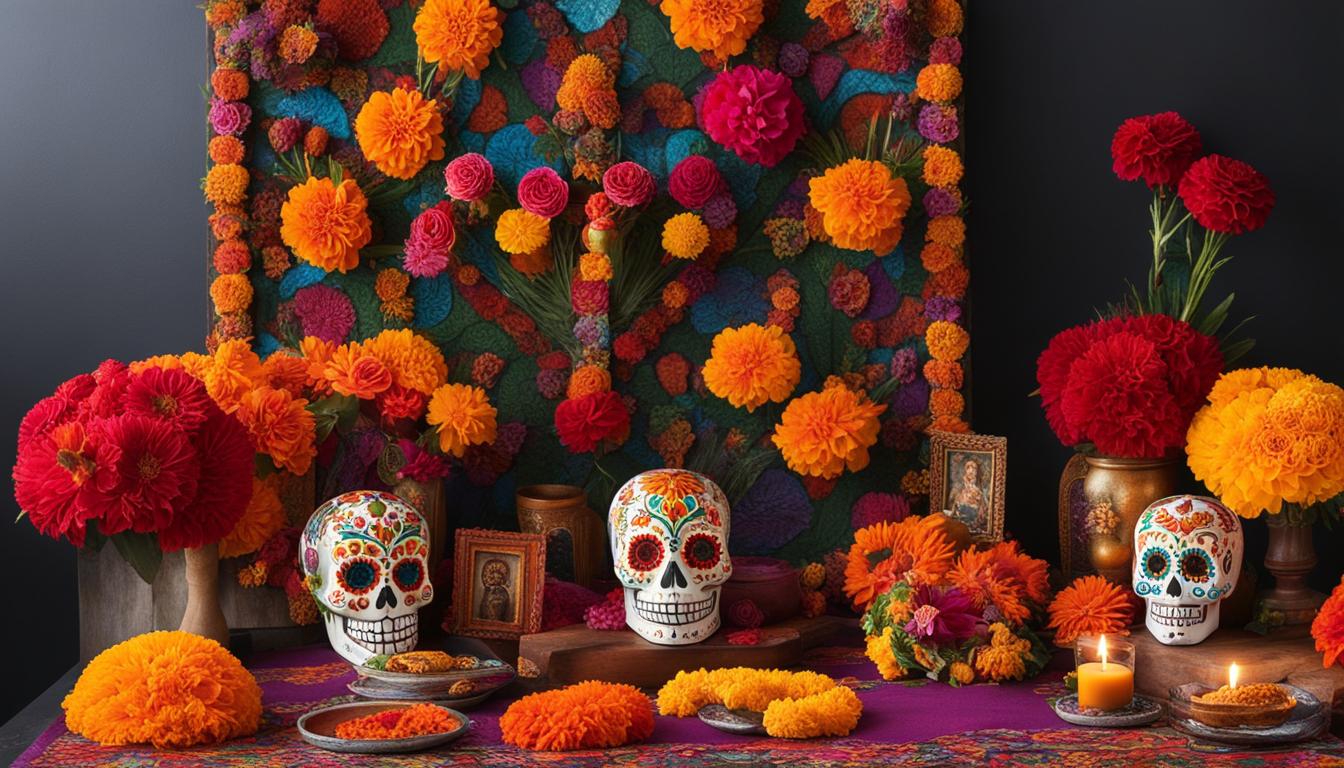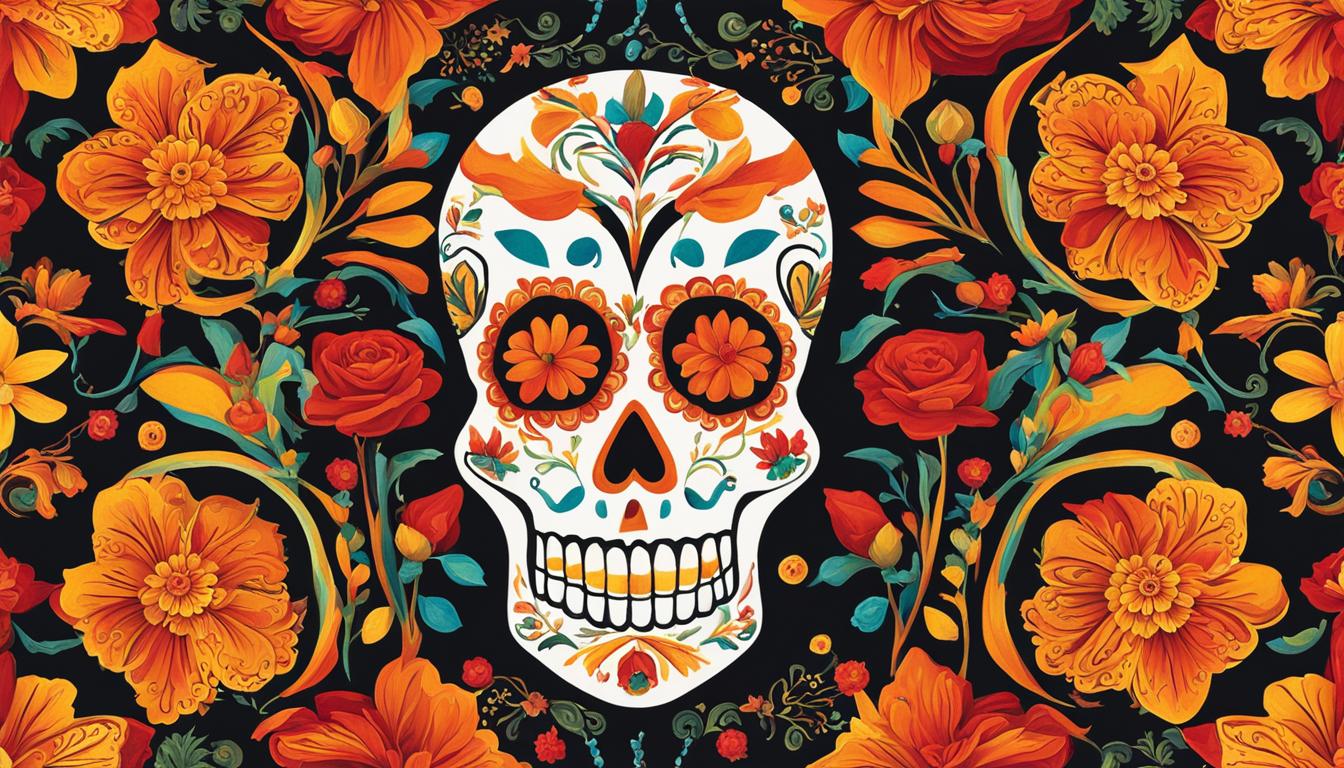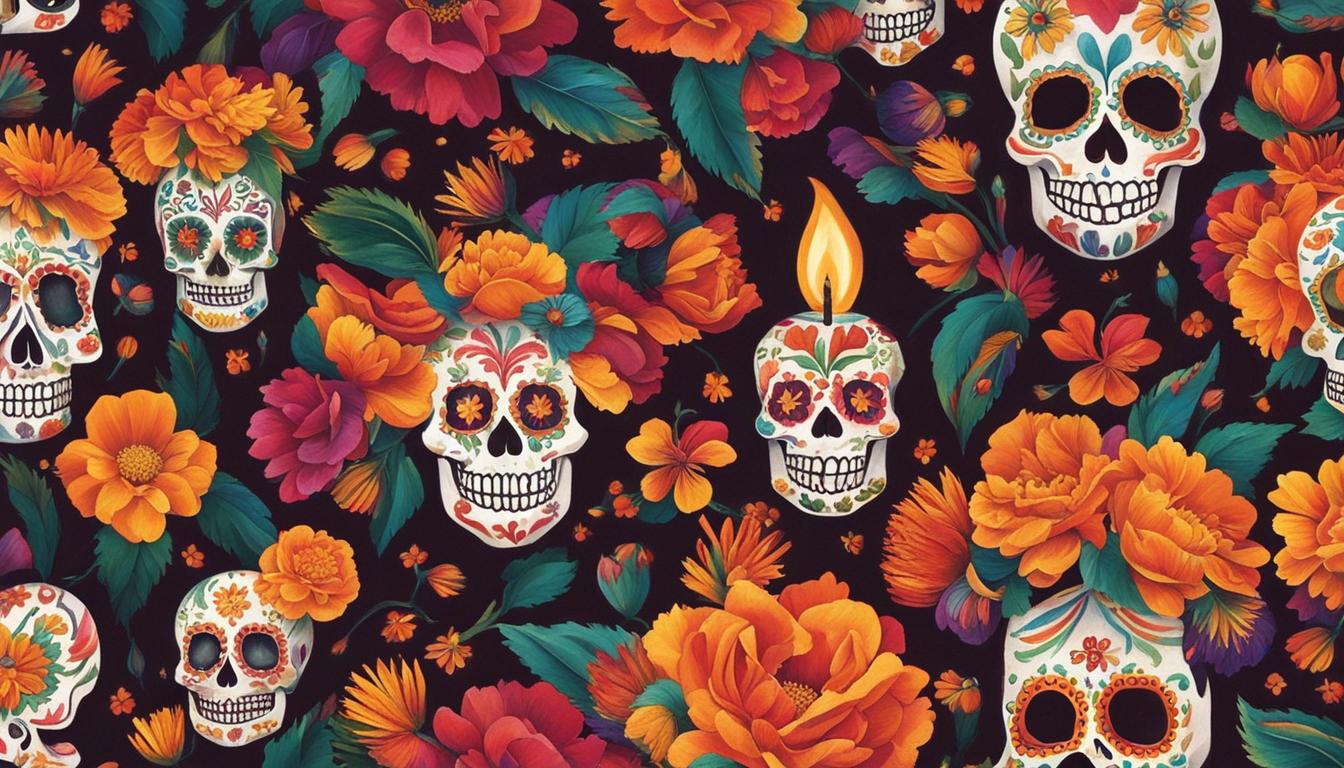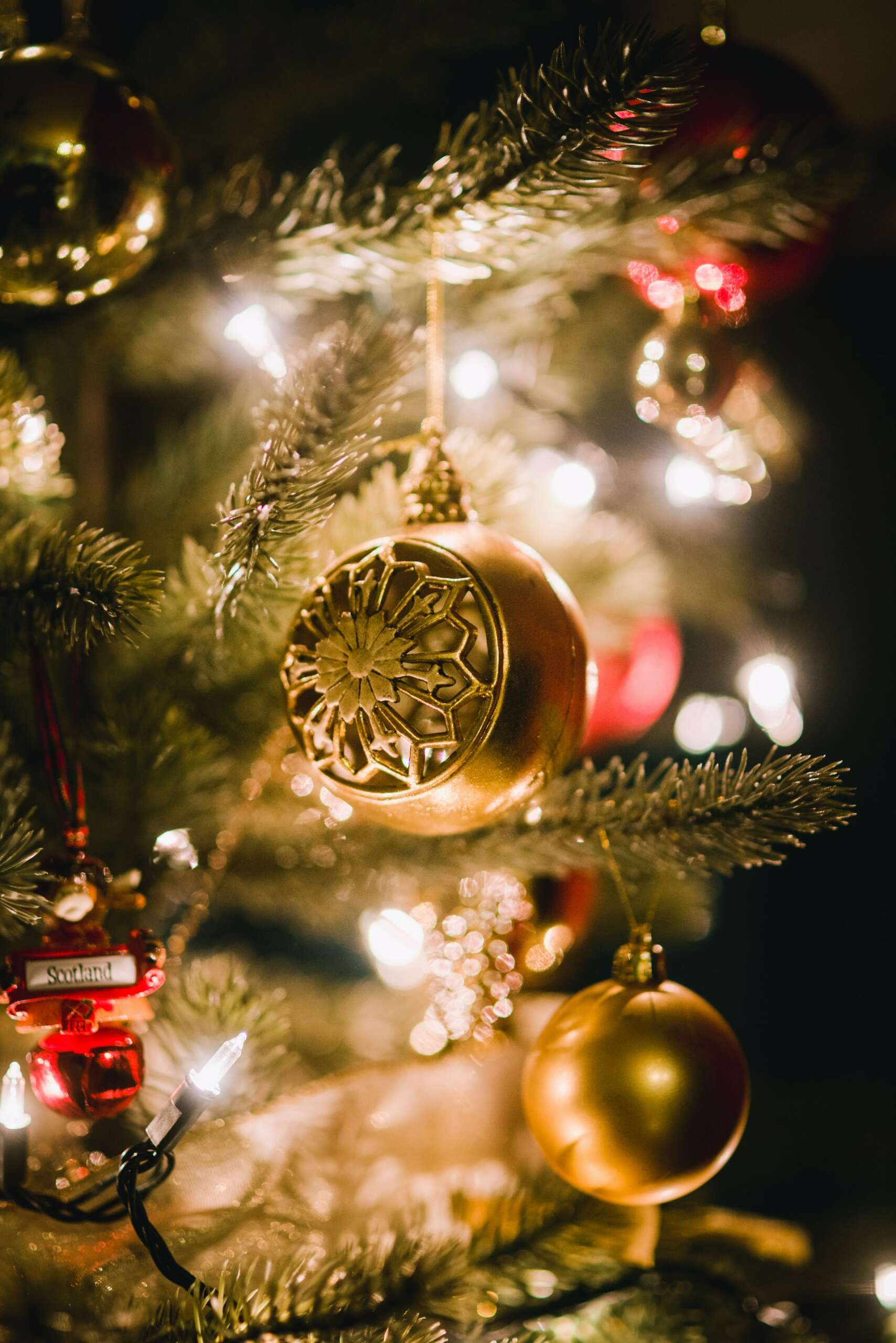The Day of the Dead, known as el Día de los Muertos in Spanish, is a vibrant tradition deeply rooted in Spanish culture. This Mexican holiday is a cultural celebration that takes place on November 1st and 2nd, dedicated to the remembrance of departed loved ones. It is a time to honor and commemorate the deceased through various festive rituals and symbolic offerings.
During the Day of the Dead, you will encounter captivating traditions such as the decoration of sugar skulls and the creation of elaborate altars adorned with marigold flowers. People participate in colorful parades wearing traditional costumes, while families gather to prepare and enjoy traditional dishes that are an integral part of the commemoration.
Step into the world of the Day of the Dead and immerse yourself in the rich cultural heritage of Spanish-speaking communities. Witness the beauty of altar decorations, learn the significance of traditional costumes, and experience the spiritual connection between the living and the departed.
Key Takeaways:
- The Day of the Dead, or el Día de los Muertos, is a Mexican holiday deeply rooted in Spanish culture.
- It is a time to honor and commemorate deceased loved ones.
- Traditions include the decoration of sugar skulls, altar preparations, and the wearing of traditional costumes.
- The celebration involves festive rituals and symbolic offerings.
- The Day of the Dead offers a unique opportunity for spiritual connection and remembrance.
Day of the Dead 2023: A Celebration of Life and Remembrance
In 2023, the Day of the Dead celebration will take place on November 1st and 2nd. This vibrant and culturally significant tradition is deeply rooted in Spanish culture and is widely observed in Mexico and by people of Mexican heritage around the world. The holiday is a time to remember and honor deceased loved ones, celebrating their lives and cherishing their memory.
During the Day of the Dead, families come together to create altars called ofrendas in their homes. These altars are decorated with photos of the deceased, favorite foods, water, candles, and traditional paper banners. Marigold flowers, known as cempazuchitl, are used to adorn the altars and attract the spirits back to the living world. Sugar skulls, or calaveras de azúcar, are also an iconic part of the celebration, symbolizing the cycle of life.
To commemorate the Day of the Dead, families participate in festive rituals that celebrate life and honor their ancestors. Many cities in Mexico, including downtown Mexico City, hold colorful parades featuring giant skeletons, vibrant costumes, mariachi music, and dance performances. Residents and tourists alike line the streets to watch the procession and join in the revelry, wearing traditional Day of the Dead costumes and colorful makeup.
The Day of the Dead is not just a holiday; it is a spiritual connection with the past and a celebration of the present. It is an opportunity to reflect on the cycle of life and death, to embrace the memories of those who have passed, and to find joy in the remembrance of loved ones. Through its rich traditions, art, and cultural festivities, the Day of the Dead offers a meaningful and enriching experience that celebrates both life and the enduring bond between the living and the deceased.
Reference:
“Day of the Dead 2023: A Celebration of Life and Remembrance.” The Day of the Dead Magazine, 2023.
What is Day of the Dead?
The Day of the Dead is a celebration of life and a time to remember and honor deceased loved ones. It is believed that during this time, the spirits of the dead return to the living world to celebrate with their families. It is a day to celebrate and cherish the lives of the departed, rather than focus on their absence. The holiday is deeply rooted in spirituality and offers a unique opportunity for families to connect with their ancestors.
During the Day of the Dead, families create altars called ofrendas in their homes to honor their deceased loved ones. These altars are adorned with photographs, favorite foods, water, candles, and traditional paper banners called papel picado. Marigold flowers, known as cempazuchitl, are also used as decorations and are believed to guide the spirits back to the ofrendas. The celebration is filled with vibrant colors, music, and the joyful remembrance of those who have passed.
“The Day of the Dead is a time to celebrate the lives of our ancestors and keep their memories alive. It is a deeply meaningful and spiritual experience that allows us to reconnect with our roots and honor the cycle of life and death.”
Symbolic Offerings
A key aspect of the Day of the Dead is the offering of symbolic gifts to the departed. These gifts, known as ofrendas, represent different elements of life and serve as offerings to nourish and comfort the spirits during their visit to the living world. Some common items found in ofrendas include:
- Pan de muerto: A sweet bread decorated with bone and skull shapes, symbolizing the circle of life and death.
- Candles: Lit to guide the spirits back to their loved ones and provide light on their journey.
The Day of the Dead is a beautiful and deeply meaningful cultural celebration that allows individuals to remember and honor their loved ones who have passed on. It is a time to celebrate life, connect with one’s spiritual roots, and embrace the cycle of existence.

Day of the Dead: Traditions
The Day of the Dead is known for its rich traditions and cultural festivities. Families gather and set up altars called ofrendas in their homes to honor their deceased loved ones. These altars are decorated with photos of the deceased, favorite foods, water, candles, and traditional paper banners called papel picado. Marigold flowers, known as cempazuchitl, are used as decorations as well as in graveyards to attract the souls back to the ofrendas. Sugar skulls, or calaveras de azúcar, are also a prominent part of the celebration and symbolize the cyclical nature of life.
During the Day of the Dead, family celebrations take place where relatives come together to remember and honor their ancestors. It is a time of reflection and connection with those who have passed away. The festivities often include special meals, music, dancing, and storytelling. It is a celebration of life that embraces the belief that the spirits of the dead return to visit their families during this time.
Ofrendas: A Sacred Tradition
One of the central traditions of the Day of the Dead is the creation of ofrendas. These altars are meticulously prepared by families and are filled with offerings that are meant to welcome the spirits of the deceased back into the living world. The ofrendas often include photographs of the departed, their favorite foods and drinks, personal belongings, and symbolic items such as papel picado and marigold flowers. The altars serve as a physical representation of the spiritual connection between the living and the dead, providing a space for remembrance and honoring the memory of loved ones.
The use of marigold flowers in the Day of the Dead celebrations holds deep symbolism. The vibrant orange and yellow colors are believed to attract the souls of the departed back to the ofrendas. Their strong scent is thought to guide the spirits home, reinforcing the belief that during this time, the veil between the living and the dead is thin, allowing for a reunion between loved ones.
Sugar Skulls: A Sweet Tradition
Sugar skulls are another important tradition in the Day of the Dead festivities. These colorful and intricately decorated skulls are made from sugar paste and are often personalized with the names of the deceased. They are placed on the ofrendas as a way to honor and remember those who have passed away. The sugar skulls not only serve as a reminder of death but also symbolize the cyclical nature of life. They are a representation of the belief that death is just a part of the journey and that the souls of the departed are never truly gone.
| Symbolism of Sugar Skulls | Meaning |
|---|---|
| Calavera | Skull, representing death |
| Flowers | Cycle of life and rebirth |
| Colors | Represent different emotions or traits of the deceased |
| Names | Personalization and remembrance of the individuals |
The Day of the Dead traditions of ofrendas and sugar skulls are deeply rooted in the cultural heritage of Spanish-speaking communities. They provide an opportunity for families to come together, celebrate the lives of their ancestors, and keep their memories alive. Through these traditions, the Day of the Dead serves as a meaningful and festive way to honor and remember those who have passed away.
Day of the Dead: Food
Food is an integral part of the Day of the Dead celebration, with traditional dishes that hold deep cultural significance. These dishes play a key role in honoring the deceased and symbolize the connection between the living and the departed.
One popular treat during the Day of the Dead is pan de muerto, a sweet bread decorated with bone and skull shapes. This bread is traditionally enjoyed by family members and can also be placed on altars as an offering to the spirits of the departed.
Another iconic dish is mole, a rich and flavorful sauce made with chilis, spices, chocolate, and fruit. Mole is often served over meat or poultry and is a staple during festive occasions, including the Day of the Dead.
A warm and comforting beverage called atole is also commonly enjoyed during the holiday. This corn-based drink is flavored with sweet fruits and provides nourishment and warmth to those participating in the celebrations.
| Traditional Day of the Dead Dishes | Description |
|---|---|
| Pan de Muerto | A sweet bread adorned with bone and skull shapes, representing life and death. |
| Mole | A thickened sauce made with chilis, spices, chocolate, and fruit, symbolizing the diverse flavors of life. |
| Atole | A warm corn-based beverage flavored with sweet fruits, providing comfort and nourishment during the celebrations. |
These traditional dishes not only satisfy the taste buds but also serve as a way to honor and remember loved ones who have passed away. They bring families together, allowing them to share stories and memories while celebrating the cycle of life and death.

“Food is the universal language of love and remembrance, and during the Day of the Dead, it becomes a heartfelt tribute to our ancestors.”
Day of the Dead: Parade
The Day of the Dead parade is a vibrant and festive procession that takes place in many cities across Mexico. It is a colorful celebration that showcases the rich cultural heritage and traditions associated with this important holiday. The parade is a visually stunning spectacle, with participants dressed in elaborate and colorful costumes, often adorned with vibrant flower crowns and intricate face paint. The streets come alive with the sounds of mariachi music and the rhythmic movements of dancers, creating a lively and joyful atmosphere.
One of the highlights of the parade is the presence of giant skeletons, known as calacas, which are symbolic representations of the cycle of life and death. These larger-than-life figures, often beautifully decorated, capture the attention and imagination of both locals and tourists alike. The parade is a true celebration of life, with participants embracing the joy and vibrancy that comes with remembering and honoring their deceased loved ones.
Day of the Dead Parade: A Cultural Extravaganza
The Day of the Dead parade is not just a visual spectacle, but also a cultural extravaganza that showcases the diverse traditions and artistic expressions associated with the holiday. It is an opportunity for communities to come together and celebrate their shared heritage, while also providing a platform for local artisans and performers to showcase their talent.
“The Day of the Dead parade is a celebration of life, a time to remember and honor our ancestors. It is a beautiful display of our culture and traditions, and a reminder of the importance of cherishing our loved ones.”
Attending the Day of the Dead parade is a unique and unforgettable experience that allows visitors to immerse themselves in the rich traditions and vibrant spirit of this cherished holiday. It is a time of joy, celebration, and remembrance, where the past and present come together in a colorful and lively procession.
Day of the Dead: Art
Art is an integral part of the Day of the Dead celebration, offering a visual representation of the holiday’s rich symbolism and traditions. One of the most iconic images associated with the Day of the Dead is the Catrina skull. Originating from the artwork of Jose Guadalupe Posada, a Mexican illustrator and cartoonist, the Catrina has become synonymous with the holiday. Posada’s skeletal illustrations gained popularity for their satirical depictions of politicians and social classes, and over time, the Catrina became a symbol of the Day of the Dead.
“I created the Catrina to mock those who deny their indigenous origins,” said Posada, highlighting the underlying social commentary of his work. The Catrina skull represents the idea that death is a universal equalizer, reminding people to embrace their mortality and honor their ancestors. This powerful symbol has become an integral part of Day of the Dead art, reflecting the celebration’s blend of humor, spirituality, and remembrance.
“To paint is in a way to contemplate. The painter paints something that, without him, that it will be what it has become under his gaze.” – Diego Rivera
The renowned Mexican muralist Diego Rivera played a significant role in cementing the Catrina’s status as a prominent Day of the Dead icon. In one of his murals, Rivera depicted the Catrina alongside other vibrant representations of Mexican culture and history. Rivera’s murals celebrated the indigenous roots of Mexico and brought attention to the country’s rich artistic traditions.
Throughout the Day of the Dead festivities, art takes various forms, including paintings, sculptures, and intricate papercraft. These artistic creations capture the spirit and essence of the holiday, providing a visual feast for participants and observers alike. Whether it’s the colorful imagery, the intricate details, or the underlying symbolism, Day of the Dead art serves as a powerful tribute to the celebration of life and the remembrance of loved ones.

Table: Influential Artists in Day of the Dead Art
| Artist | Contribution |
|---|---|
| Jose Guadalupe Posada | Originated the Catrina skull and popularized skeletal illustrations |
| Diego Rivera | Featured the Catrina in one of his murals, solidifying its iconic status |
Conclusion
The Day of the Dead is a vibrant and culturally significant celebration that allows people to come together and remember their deceased loved ones. This vibrant tradition, deeply rooted in Spanish culture, is a time to celebrate life, honor ancestors, and reflect on the cycle of life and death.
Recognized by UNESCO as an important cultural heritage of humanity, the Day of the Dead is more than just a holiday; it is a powerful expression of remembrance and connection. Through the creation of altars, the decoration of sugar skulls, and the offering of symbolic gifts, individuals and families engage in meaningful rituals that celebrate both life and the remembrance of those who have passed on.
Whether it’s participating in colorful parades, indulging in traditional dishes, or appreciating the art that captures the spirit of the holiday, the Day of the Dead provides a unique and enriching experience. It serves as a reminder of the importance of family, the power of tradition, and the eternal bond between the living and the deceased. As individuals and communities come together to commemorate this vibrant tradition, they honor their cultural heritage and keep the memories of their loved ones alive.
FAQ
What is the Day of the Dead?
The Day of the Dead, known as el Día de los Muertos in Spanish, is a vibrant tradition deeply rooted in Spanish culture. It is a celebration to remember and honor deceased loved ones.
When is the Day of the Dead 2023?
The Day of the Dead celebration in 2023 will be held on November 1st and 2nd.
What are the traditions of the Day of the Dead?
The Day of the Dead is marked by various traditions, including the creation of altars, the decoration of sugar skulls, the wearing of traditional costumes, the offering of symbolic gifts, and the participation in festive rituals that celebrate life and commemorate the deceased.
What food is associated with the Day of the Dead?
Traditional food plays a significant role in the Day of the Dead celebration. Some popular dishes include pan de muerto, mole, and atole.
Is there a Day of the Dead parade?
Yes, many cities in Mexico hold colorful Day of the Dead parades, featuring giant skeletons, vibrant costumes, mariachi music, and dance performances.
What is the significance of the Catrina skull?
The Catrina skull is a prominent symbol of the Day of the Dead. It originated from the artwork of Jose Guadalupe Posada and gained popularity through murals by Diego Rivera.



